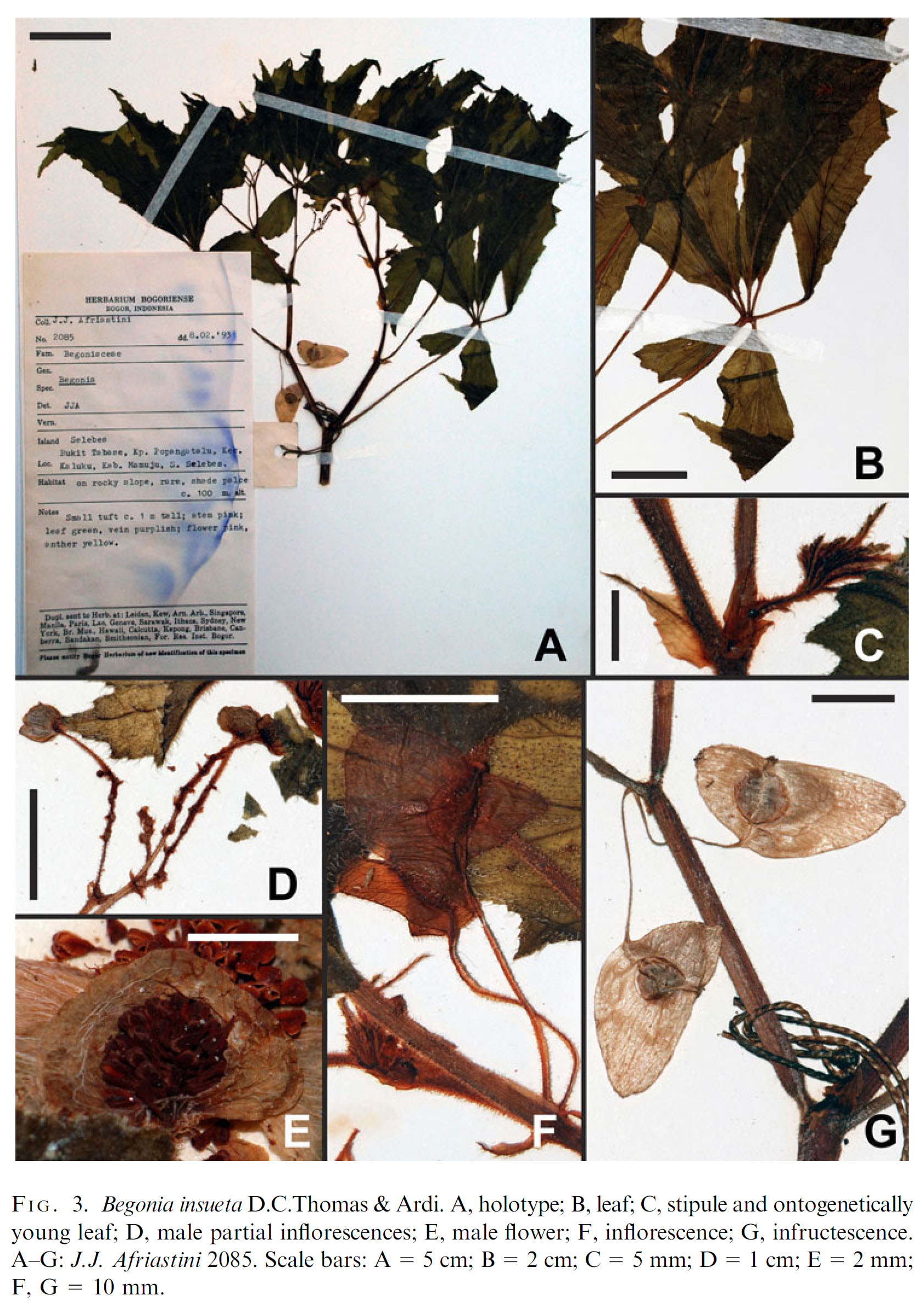Begonia insueta, nom. val., in Edinburgh J. Bot. 68(2): 230. 2011
Primary tabs

Diagnosis
- Species distinctissima. A ceteris speciebus celebicis foliis palmatim compositis, pedunculis inflorescentiarum feminearum brevibus, pedicellis florum feminearum longis et alis fructuum inaequalibus differt. - Type: Indonesia, Sulawesi, Sulawesi Barat, Kab. Mamuju, Kec. Kaluku, Kp. Popangatalu, Bukit Tabase, c.100 m, 8 ii 1993, J.J. Afriastini 2085 (holo BO). (Thomas, D.C., Ardi, W.H. & Hughes, M., Nine new species of Begonia (Begoniaceae) from South and West Sulawesi, Indonesia in Edinburgh Journal of Botany 68(2). 2011)
Description
- Perennial, monoecious herb, with erect stems, to c.100 cm tall, with a moderately dense to dense indumentum of multicellular, simple trichomes up to c.0.6 mm long and a sparse indumentum of microscopic, glandular trichomes on all above-ground vegetative parts. Stems branched; internodes c.3.9-7.2 cm long.
Leaves alternate; stipules caducous, 6-11 × 2.5-5 mm, ovate, with an abaxially prominent midrib that projects c.2-4 mm at the apex; petioles c.4-10 cm long; lamina basifixed, palmately compound with 5-7 leaflets, each leaflet 2.9-9.5 × 1.6-2.5 cm, asymmetric, ovate or ellipsoid, base cuneate to concavo-convex, apex acuminate, margin irregularly serrate to biserrate, teeth bristle-pointed, primary veins 5-7, actinodromous, secondary veins craspedodromous.
Inflorescences: female inflorescences 2-flowered, solitary, peduncles c.0.5-1 mm long; male inflorescences solitary, partial inflorescen- ces monochasial with short but well-developed axes, each monochasium with c.5-7 flowers.
Male flowers: pedicels c.2-3 mm long; tepals 2, pink, 4-5 × 3-4 mm, broadly ovate to suborbicular, base cordate, apex rounded, abaxially with a sparse indumentum of multicellular hairs; androecium of c.28-42 stamens, yellow, filaments up to c.0.8 mm long, slightly fused at the base, anthers up to c.0.6 mm long, obovate, dehiscing through unilaterally positioned slits that are >1/2 as long as the anther.
Female flowers: pedicels 15-19 mm long; tepals unknown; ovary ellipsoid, with a sparse indumentum of microscopic hairs and a sparse indumentum of multicellular hairs, locule number and placentation unknown, wings 3, strongly unequal, tri- angular, base rounded to cuneate, apex subtruncate to rounded, style unknown.
Fruiting pedicels 16-19 mm long. Fruits subglobose, c.6-7 × 5-6 mm (excluding the wings), sparsely hairy to glabrescent, dehiscent, splitting along the wing attachment, wing shape as for ovary, the largest c.14-16 mm wide at the widest point (subapi- cally), the two smaller c.6-8 mm wide at the widest point (subapically); seeds ellipsoidal, c.0.3 mm long, collar cells c.1/2 of the length of the seed. (Thomas, D.C., Ardi, W.H. & Hughes, M., Nine new species of Begonia (Begoniaceae) from South and West Sulawesi, Indonesia in Edinburgh Journal of Botany 68(2). 2011)
Habitat
- This species was observed growing on a rocky slope, in full shade, at c.100 m above sea level.
Conservation
- Proposed IUCN conservation category: Data Deficient (DD). The species is only known from one collection. The locality could not be georeferenced with certainty, and the population has not been observed in the field. (Thomas, D.C., Ardi, W.H. & Hughes, M., Nine new species of Begonia (Begoniaceae) from South and West Sulawesi, Indonesia in Edinburgh Journal of Botany 68(2). 2011)
Distribution
Asia-Tropical: Sulawesi (Sulawesi endemic)
Endemic to Indonesia, Sulawesi, West Sulawesi.
See Images for a distribution map.
See Images for a distribution map.
Etymology
- The species epithet insueta is derived from insuetus (Latin - unusual). It refers to the unusual morphological characters exhibited by this species (see notes below).
Notes
- Begonia insueta can be placed in Begonia section Petermannia based on the two-flowered female inflorescences and the anthers dehiscing through unilaterally positioned slits (see Images). However, it exhibits several characters which are rare in this large and morphologically diverse section including unequally sized fruit wings and palmately compound leaves, which have only been described from three other species in the Malesian region: Begonia oligandra Merr. & L.M.Perry, B. polilloensis Tebbitt and Begonia rachmatii Tebbitt (see key in Tebbitt, 2005). The Sulawesi Begonia rachmatii is morphologically dissimilar to B. insueta and can be differentiated by multiple characters including the solitary female flowers, very short pedicels of the female flowers (c.1 mm long), and wings which are subequal in size (see key below). The distinctly unequal wings of the fruits in Begonia insueta are highly uncommon in Begonia section Petermannia. However, strongly unequal fruit wings can also be found in the New Guinean species Begonia oligandra, which also exhibits palmately compound leaves. This species has tentatively been assigned to Begonia section Diploclinium (Lindl.) A.DC. by Doorenbos et al. (1998), but the lack of specialised underground organs like rhizomes or tubers indicates that its affinities are with New Guinean species in Begonia section Petermannia. However, the well-developed stalks and the serrate margins of the leaflets of Begonia insueta allow easy differentiation of this species from B. oligandra, which exhibits pinnatifid to bipinnatifid leaflets with extremely short stalks. The leaf morphology of the Philippine endemic Begonia polilloensis is similar to B. insueta, but the leaflets of B. polilloensis are not distinctly stalked, the female flowers are solitary, and the fruit wings are subequal in size. (Thomas, D.C., Ardi, W.H. & Hughes, M., Nine new species of Begonia (Begoniaceae) from South and West Sulawesi, Indonesia in Edinburgh Journal of Botany 68(2). 2011)

